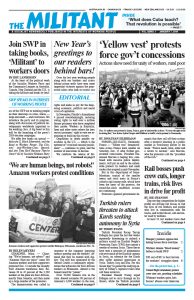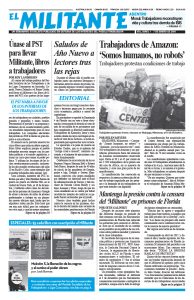Dog-eat-dog competition for higher profits are driving rail bosses to risk the lives of rail workers and people who live in communities near the tracks, and to foul the air, soil and water used by millions.
At least 22 rail workers have died on the job so far this year in North America. Eight have died in Canada since April 2017 when three workers were killed after an Englewood Railway forestry train derailed and rolled into the work equipment vehicles they were on. The most recent death was 33-year-old Pierre-Luc Levesque, a trainee working for Canadian National who was killed Dec. 4 in Edmundston, New Brunswick.
The deaths represent a sharp increase over recent years in Canada. Rail workers there carried out a strike against Canadian Pacific in May, protesting long and exhausting work schedules that compromise safety.
“In recent years, the railroads are running mega-trains, up to 250 rail cars plus seven to eight locomotives, and this is a huge safety issue,” Lance Anton, a 41-year-old conductor and SMART union member in Lincoln, Nebraska, told the Militant. “Rail bosses do this to cut crews, but the union should fight such work conditions in the interest of rail workers and the people who live near the rail.”
Bosses have succeeded in imposing one-person train operation over the road in some places and on some yard jobs. One effort to impose the one-person crew by the BNSF Railway in 2014 was defeated. SMART union members campaigned against a draft contract that would have allowed it and voted it down.
One consequence of smaller crews is that new hires do not get to work as a brakeman or switchman for their first few years on the job before being required to work as conductors, with full responsibility for commanding train movement. “New hires get training of only 12 weeks. Though the union has some influence in the training, it is far from enough,” said Anton, “It takes two to three years just to become knowledgeable of large rail yards.”
CSX Transportation bosses have reduced rail school for new hires from six to three weeks. They have also cut job training time in some cases. In the last six months bosses at both CSX and Norfolk Southern have implemented new rules that will require workers to ride oil tanker cars with only one vertical grab iron while making a shove, despite proven dangers of doing so.
Cost cutting measures that increase workload and expose crews to greater dangers helped CSX achieve larger returns for their stockholders. They have sought to win support from workers for these changes by making stock shares available at discounted rates and paying blood money bribe bonuses to engineers if they help bosses meet their profit goals.
Runaway iron ore train in Australia
On Nov. 5 a fully loaded 268-car BHP freight train hauling iron ore in Western Australia’s Pilbara region rolled 57 miles with no one at the controls. The train reached speeds of 110 mph, after the lone crew member dismounted to inspect a car.
Operators some 800 miles away were able to remotely derail the train in a desert area. Mangled tracks and wrecked rail cars scattered among mounds of spilled iron ore halted rail operations there for at least a week.
Nevertheless, bosses are pressing ahead not only on one-person crews but on running driverless trains. At the end of November, three-quarters of the iron ore trains operated by Rio Tinto PLC in the Pilbara region were driverless. U.S. rail bosses are looking into launching crewless trains as well.

